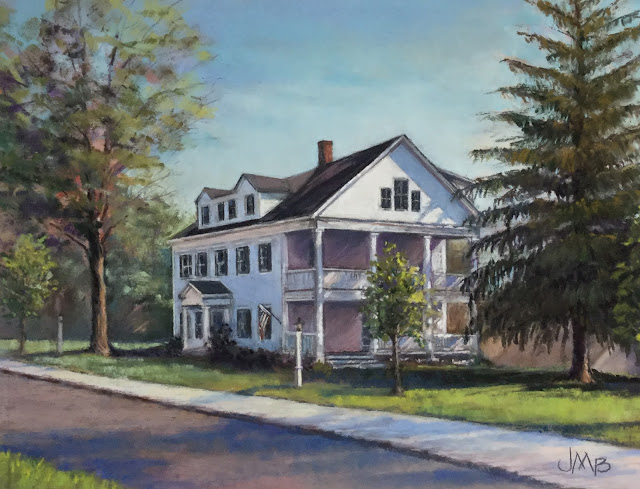Increasingly the power of Southbury Conn., artist Tom Adkins’ paintings lies in his power to pull off a form of artistic alchemy. He doesn’t merely produce masterful realistic landscapes and seascapes, he manages to synthesize the feeling of a place at the exact moment when its emotional impact has reached an apogee—one that will be gone in a flash but also remains forever in Adkins’ painting of the scene.
“My goal is to capture that fleeting moment in time when atmospheric conditions and lighting, along with the natural design in nature, seem to bring a bit of magic to the landscape,” the artist says, and he has done that better than ever in the 30 new Connecticut landscapes and Maine seascapes to be presented in a solo exhibition Oct. 8 through Nov. 12 at the Gregory James Gallery in New Milford. An opening reception is scheduled for Oct. 8, from 5 to 7 p.m. at the gallery.
“I’m trying to capture that moment in time. It has an effect on me and that’s what I try to share with people,” elaborates the artist, who mentions a particular fondness for a painting of a bucolic twilight scene in Bethlehem, Conn. As a cow drinks along the edge of farm pond flushed with the reflection of the orangey-peach sunset, above still-green grass salted by early snow, geese hasten toward warmer climes and bare trees stand like sentinels of winter. “I have noticed over the years with these solo exhibitions that my work is getting much more defined,” Adkins says. “All paintings start out very rough and painted in a broad brush stroke, and as the painting develops and I push and pull the warm and cool tones helping to enhance the sense of perspective and atmosphere striving for that reality of location.”
For Thomas Adkins, it’s not simply a matter of heading to his outdoor “office” and finding the perfect situation in the rural hills of Northwest Connecticut or the coast of Maine, where he has a property.
“I spend a great deal of time traveling to familiar locations in New England waiting for those special conditions,” the artist says.
When everything is right about the place and time, then the challenge begins for this veteran en plein air painter. “It is my desire to share with others that special bond we have as humans with the natural beauty around us, which is so often lost in the day-to-day challenges of life,” he says. “Creating a painting is not about copying a subject, it’s more about transferring your feeling and thoughts, your first impression and something about yourself to the canvas. In landscape painting, you’re not painting an object like a portrait, your composing a color and compositional score not unlike a musical score and hopefully your viewers will have felt that experience.”
Traveling back and forth between Maine and Connecticut offers the artist a great deal of geographic variety, although the hills around Litchfield county and coastal Maine have a very similar quiet presence, Adkins says. However, the lighting is quit different. Maine seems to have a softer and cooler feel than Connecticut’s brighter condition.
“The small towns and villages of both locations share something unique I believe a wonder of what it may have been like in years gone by,” the artist says.
Thomas Adkins has been showing and exhibiting for over 30 years in some of the Northeast’s finest galleries and has won numerous awards. He has shown in number of museums and is in the Permanent Collection of the New Britain Museum of Fine Art. A graduate of Paier College of Art of New Haven, who also completed graduate classes at the School of Visual Arts of New York, he has worked as art director and creative director for some of Connecticut’s and New York’s most prestigious advertising agencies.
For more information, call the Gregory James Gallery at (860) 354-3436. The gallery’s website is www.gregoryjamesgallery.com, and the artist’s website is www.thomasadkinsfineart.com.
For more area information and to sign up for our monthly newsletter www.litchfieldhills.com







